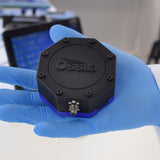Spontaneous and Stimulated Emission

Spontaneous and Stimulated Emission are essential phenomena to consider when evaluating the suitability of organic semiconducting molecules for laser applications. Amplified spontaneous emission (ASE) serves as a reliable indicator of its potential. ASE is the process used by lasers to amplify light. There are three important optical transitions that happen during ASE:
-
Population inversion: absorption from an excitation source (pump laser) excites enough molecules in your medium so that there are more molecules in the excited state than in the ground state.
-
Spontaneous emission: an excited state randomly relaxes to the ground state through the emission of a photon. This is referred to as spontaneous emission.
-
Stimulated emission: when a photon stimulates another excited state to relax and emit a photon. This emitted photon is identical to the one that instigated the transition. Therefore, both photons are spatially and temporally identical.
ASE occurs when of all the above transitions combine. This begins when a laser optically pumps an organic material with enough power to create a population inversion via absorption. Then, one of the excited states undergoes spontaneous emission and thus emits a photon. This emitted photon can then guide the emitted waves (or waveguide) through the bulk of the material and stimulate another excited state to emit an identical photon. The two photons can then keep stimulating other excited states, causing a ‘snowball’ effect of amplification of identical photons. This amplification of identical photons is what drives a laser.
Fluence Definition
The fluence is the amount of energy delivered per unit area from a radiating source. The units for fluence are measured in J/cm2, which is the standard for comparing fluence measurements. As fluence takes into account area, this gives a more accurate representation of the energy being delivered to a system. For example, exciting a material with a laser with a small and large spot size will result in two different reginal excitation energies. This is why calculating the fluence makes for a much more comprehensive measurement when compared to just taking the total energy. Therefore, fluence is typically the favored excitation measurement used in spectroscopy.
How to Measure Amplified Spontaneous Emission?
You can measure ASE by exciting an organic film with a laser. This laser must be focused through a cylindrical lens (as shown in the image below) as it will excite a stripe of molecules in the organic film. As a result, spontaneously emitted light will waveguide through an area of the film that is in a state of population inversion. As this happens, the spontaneously emitted light will also induce a stimulated emission from other excited states, and a cascade of identical photons will escape the edge of the film. You can collect the ASE emission from the edge of the film using an optical fiber connected to a USB spectrometer.
Under the laser stripe, the ratio of molecular excited states to ground states is directly proportional to the pump fluence of the laser. However, there needs to be more excited states than ground states to create a population inversion. At a low pump fluence, the number of excited states is fewer and therefore there is no population inversion. As a result, loss mechanisms will now prevent the stimulated emission amplification process. An example of one of these loss mechanisms is the random directional emission of spontaneously emitted light. This means that most of this light is emitted directly out of the path of the stripe. Emission at low power is therefore similar to normal PL where spontaneous emission dominates.
As the pump fluence increases and reaches a certain threshold, a population inversion is created. At this point, stimulated emission will take over as the dominant emission pathway. You can see this in the narrowing of the emission collected from the edge of the film as well as the rapid increase in intensity. Example of both effects is shown in the graphs below. By increasing the pump fluence and capturing the emission using a spectrometer, you can find the ASE threshold of the lasing material. At this lasing threshold, the gradient of your pump fluence vs. intensity graph will change dramatically.
If the material has a low ASE threshold, there is a good chance that it will be useful as a gain medium for a laser. The threshold has units of µJ/cm2 and can be calculated by dividing the pump energy of the laser by the area of the stripe.
USB Spectrometer

Learn More
 Photoluminescent Spectroscopy
Photoluminescent Spectroscopy
Photoluminescence refers to a form of luminescence that results from photoexcitation. Simply, photoluminescence occurs when a material emits light after absorbing a photon from an external light source and is measured using a spectrometer such as an optical spectrometer.
Read more...Organic semiconductors are materials, ranging from small molecules to polymers, that can transport charge. Unlike in conductors, where electrons move freely across the material, organic semiconductors rely on a structure primarily composed of carbon and hydrogen atoms.
Read more...